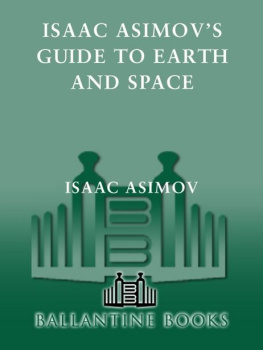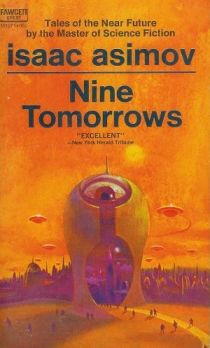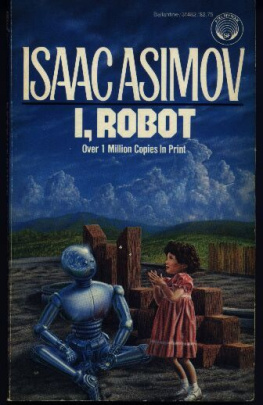REACH FOR THE STARS.
- How hot is the sun?
- Are the laws of nature the same everywhere?
- Is there life on planets circling other stars?
- Does anything reach us from the stars besides light?
- Is there a center of the universe?
- How old is the universe?
- What are quasars?
- Can we see the big bang?
- Will the expansion of the universe continue forever?
- Is there matter in the universe we cant see?
For clear, concise answers to these
and many more questions, turn to
ISAAC ASIMOVS
GUIDE TO EARTH AND SPACE.
Also by Isaac Asimov:
BANQUETS OF THE BLACK WIDOWERS*
THE BEST MYSTERIES OF ISAAC ASIMOV*
CASEBOOK OF THE BLACK WIDOWERS*
TALES OF THE BLACK WIDOWERS*
MORE TALES OF THE BLACK WIDOWERS*
THE UNION CLUB MYSTERIES*
A WHIFF OF DEATH*
ASIMOVS CHRONOLOGY OF SCIENCE AND DISCOVERY
ASIMOVS NEW GUIDE TO SCIENCE AND
TECHNOLOGY
THE HISTORY OF PHYSICS
*Published by Fawcett Books
A Fawcett Book
Published by The Random House Publishing Group
Copyright 1991 by Nightfall, Inc.
All rights reserved.
Published in the United States by Fawcett Books, an imprint of The Random House Publishing Group, a division of Random House, Inc., New York, and simultaneously in Canada by Random House of Canada Limited, Toronto.
Fawcett is a registered trademark and the Fawcett colophon is a trademark of Random House, Inc.
www.ballantinebooks.com
Library of Congress Catalog Card Number: 91-11097
eISBN: 978-0-307-79227-3
This edition published by arrangement with Random House, Inc.
v3.1
TO KATE MEDINA
together again
CONTENTS
INTRODUCTION
The physical world is a large and wonderful place, but it is also confusing, and there is much about it that no one quite understands. There are also many phenomena that some of us understand pretty well, but others do not.
One of the reasons that most of us dont know as much about the world as we might is simply that we dont bother to think about it. Which is not to say that we dont think at all. Everyone thinks, but each person tends to concentrate mostly on matters that seem to be of immediate importance. What shall we have for dinner? How do I pay my bills? Where shall I go for a vacation? How can I go about getting a promotion and a raise in pay? Shall I try to arrange a date with so-and-so? Whats this funny pain I have in my side?
These are such important questions to each of us, and our need to answer them is often so strong that there is simply no time to wonder about more general issues such as: What is the shape of the Earth? A natural response to a question like this might be: Who cares? Why do you bother me with such silly things? What difference does it make?
But it does make a difference. For example, you cant sail a ship across the ocean and reach your destination by the shortest possible route, or fire a missile and expect it to land on its target, without knowing the shape of the Earth.
But aside from that, and far more important, is that wondering about such questions is fascinating, and finding the answers is fairly easy if youre systematic about it. The aim of this book is to bring these general questions closer to home, by exploring their answers in terms that anyone can follow, making the complexities of the universe absolutely clear.
Of course, one question usually leads to another. Knowledge about the world is not a straight line but an intricately connected three-dimensional lacework, so that answering a particular question sometimes requires an explanation of something else, which in turn demands the explanation of still another thing, and so on. I will, however, attempt to unravel the threads with as much care as possible so that not too much has to be explained at any one time. Nevertheless, it might still be necessary for me to jump about a bit now and then, and I ask forgiveness for that.
Then, too, as we advance from question to question, simple reasoning in some cases will not be enough; we will have to know a little about what scientists have observed and deduced. But I will try to describe that work with particular care and, wherever possible, without complex mathematics or diagrams. Thinking always leads to more thinking, and theres no end to it. To people who enjoy thinking, that is the glory of science. People who dont enjoy thinking about things that dont concern them immediately, find the necessity of continuing to do so indefinitely frightening, and they turn away from science. I hope you are in the first group.
So let us get started with the question I have already asked and see where that will take us.
1. WHAT IS THE SHAPE OF THE EARTH?
To begin with, we must look around us and see that the Earth is uneven and has no easily described shape. Even if we ignore houses and other man-made objects, and all living things as well, we are still left with an uneven surface of bare rock and soil.
The first conclusion we would come to, then, would be that the Earth is a lumpy object with hills and valleys, cliffs and ravines. In places like Colorado, Peru, or Nepal, where there are towering mountains that reach miles into the air, the Earths irregularity is very clear. But if you live in some parts of Kansas or Uruguay or the Ukraine, you dont see much in the way of hills or valleys; you see plains, which look pretty flat.
Then, too, even if you do encounter hills and mountains, the Earth may rise on one side, but then fall again on the other side. Valleys and ravines may slant down on one side, but slope up on the other. No part of the Earths land surface goes up without ever coming down again as you move across it; no part goes down without ever going back up. It seems reasonable, then, to conclude that the Earth is, on the average, flat.
Again, if you were to paddle a boat out onto a body of water so large that you couldnt see land in any direction, you would have only the surface of the water to consider. This surface is uneven because it is full of waves. Yet if there is no wind, the waves are not large, and it is easy to see that, on the average, the water surface is flat. In fact, water is much more nearly flat at all times than land.
So it makes sense to suppose that the Earth is flat, and for thousands of years that is exactly what human beings believed. Since a flat Earth made sense and since it didnt take much thinking to see that it made sense, why would anyone waste any further time thinking about it?
Have you ever stood on a hilltop and looked out on the valley below? The valley looks pretty flat and you can look farther and farther outward, past houses, trees, rivers, and other faraway objects, though the more distant they appear to be, the less detail you can make out. Whats more, the air isnt usually absolutely clear; bits of fog and smoke obscure the very distant portion, which becomes a kind of bluish haze where the Earth and sky seem to meet.

The meeting place of earth and sky is called the horizon, from a Greek word for boundary. If youre looking at a flat section of the Earth, the horizon runs evenly from right to left, and such a line is therefore called

















